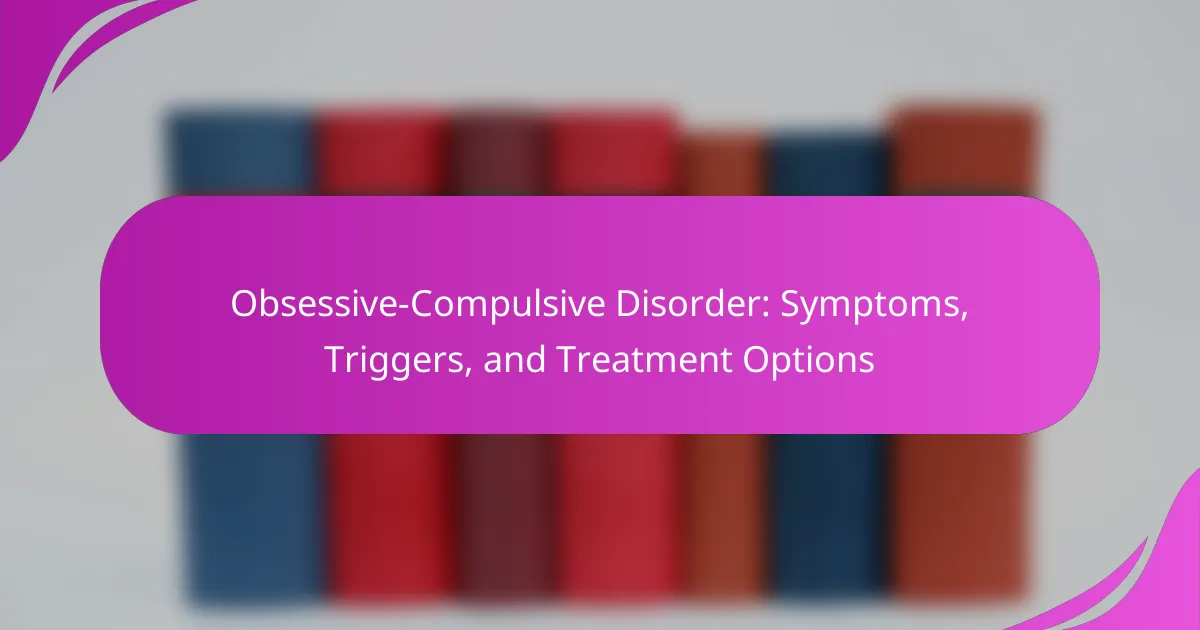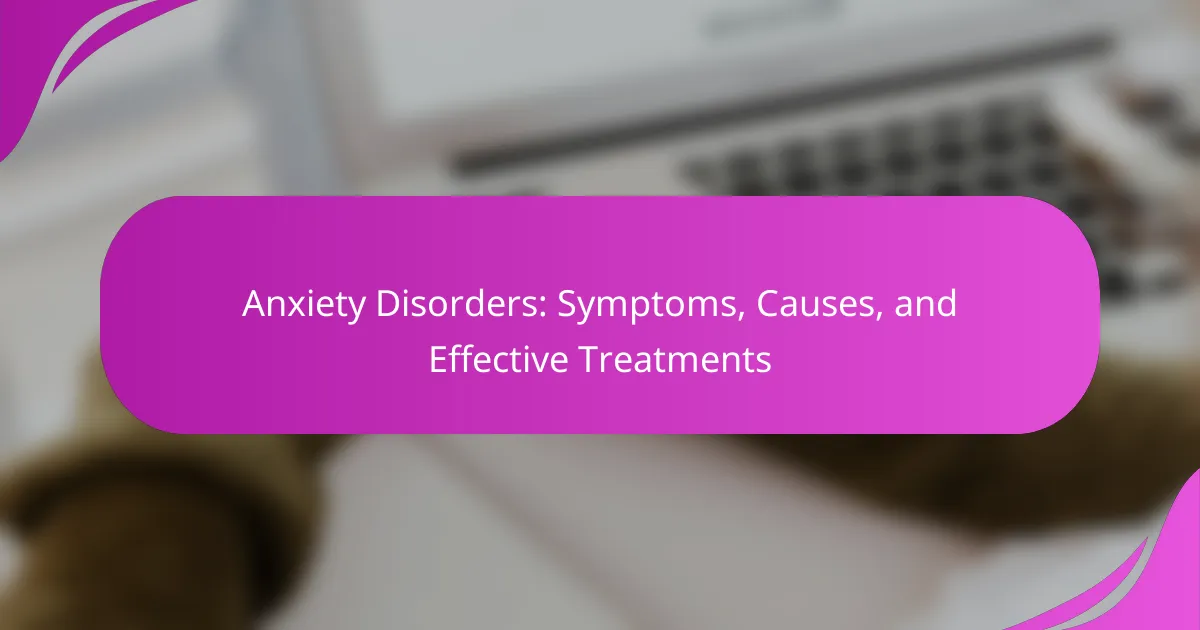Bipolar disorder presents significant challenges due to its extreme mood swings, impacting daily life. This article covers the diagnostic criteria, genetic and environmental influences, and effective management strategies. Key approaches include medication, therapy, and lifestyle changes to stabilize mood and improve quality of life. Understanding these aspects is essential for effective coping and treatment.

What is Bipolar Disorder?
Bipolar disorder is a mental health condition characterized by extreme mood swings, including emotional highs (mania or hypomania) and lows (depression). Diagnosis typically involves clinical assessment and patient history. Management strategies include medication, therapy, and lifestyle changes to stabilize mood and enhance quality of life.
How does Bipolar Disorder manifest in different individuals?
Bipolar disorder manifests differently in individuals through varying mood episodes and symptoms. Some experience intense manic phases characterized by heightened energy, while others may face debilitating depressive episodes.
Unique attributes include rapid cycling, where mood changes occur frequently, and mixed episodes, which combine manic and depressive symptoms. These variations affect diagnosis and management strategies significantly. Understanding these differences is crucial for tailored treatment approaches.
What are the main types of Bipolar Disorder?
Bipolar disorder primarily consists of four main types: Bipolar I, Bipolar II, Cyclothymic Disorder, and Other Specified and Unspecified Bipolar and Related Disorders. Bipolar I is characterized by manic episodes lasting at least seven days, while Bipolar II involves a pattern of depressive episodes and hypomanic episodes. Cyclothymic Disorder features periods of hypomanic symptoms and depressive symptoms lasting for at least two years. The other specified and unspecified categories capture bipolar symptoms that do not fit the other types but still cause significant distress or impairment.
What are the common symptoms associated with Bipolar Disorder?
Bipolar disorder commonly presents with mood swings that include episodes of mania and depression. Symptoms of mania may involve increased energy, reduced need for sleep, and impulsive behavior. Depressive episodes typically feature low energy, sadness, and feelings of hopelessness. Other symptoms include difficulty concentrating, changes in appetite, and thoughts of self-harm. These symptoms can vary in intensity and duration, impacting daily functioning.
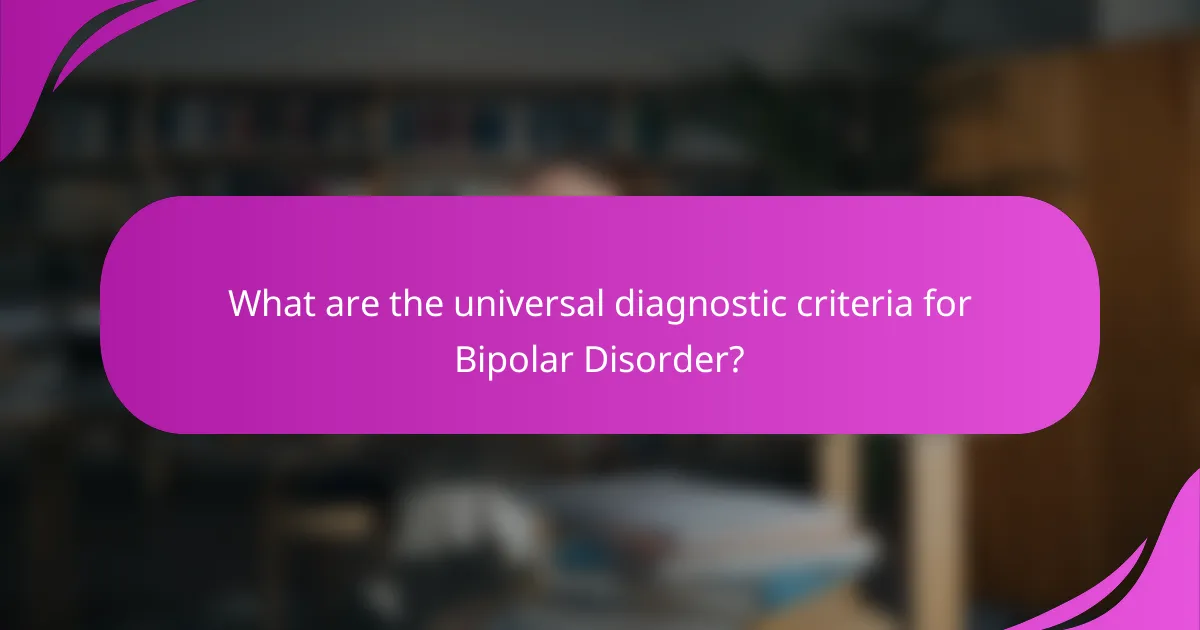
What are the universal diagnostic criteria for Bipolar Disorder?
The universal diagnostic criteria for Bipolar Disorder include distinct episodes of mania, hypomania, and depression. These episodes must last a specific duration and cause significant impairment. The DSM-5 outlines these criteria, emphasizing the necessity of mood changes and the impact on daily functioning.
How is Bipolar Disorder diagnosed by healthcare professionals?
Bipolar disorder is diagnosed through a comprehensive evaluation by healthcare professionals. This process includes clinical interviews, mood charting, and standardized assessment tools.
Healthcare providers often gather detailed patient histories to identify patterns of mood changes. They may also consider family history, as genetics can play a role in bipolar disorder.
Diagnostic criteria from the DSM-5 guide the evaluation process. Clinicians assess the presence of manic, hypomanic, or depressive episodes to confirm the diagnosis.
Regular follow-ups are essential for monitoring symptoms and adjusting treatment plans. This ongoing assessment helps ensure effective management strategies tailored to individual needs.
What role do mood charts play in diagnosis?
Mood charts play a crucial role in diagnosing bipolar disorder by tracking emotional patterns over time. They help clinicians identify mood fluctuations, assess the severity of episodes, and establish a clearer diagnostic picture. By documenting these changes, patients provide valuable data that can reveal the frequency and duration of manic and depressive episodes. This systematic approach enhances the accuracy of diagnosis and informs tailored management strategies. Additionally, mood charts can highlight unique patient attributes, such as triggers or specific symptom patterns, which further support effective treatment planning.
What are the challenges in diagnosing Bipolar Disorder?
Diagnosing Bipolar Disorder presents several challenges, primarily due to overlapping symptoms with other mental health conditions. Misdiagnosis can occur because mood swings may resemble those in depression or anxiety disorders. Additionally, the variability in symptom presentation complicates recognition. Patient reluctance to disclose symptoms further hinders accurate diagnosis. A comprehensive assessment involving detailed patient history and standardized screening tools is essential for effective diagnosis.
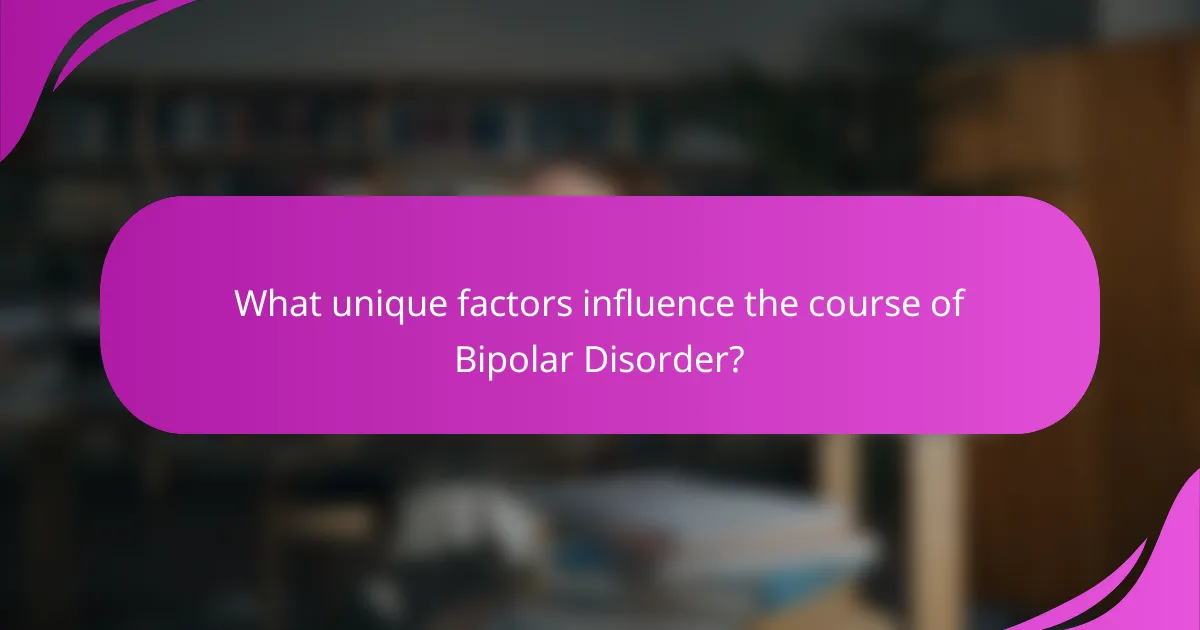
What unique factors influence the course of Bipolar Disorder?
Genetic predisposition, environmental triggers, and neurobiological factors uniquely influence the course of Bipolar Disorder. Genetic factors include family history, which significantly increases risk. Environmental triggers encompass stress, trauma, and substance abuse, often exacerbating mood episodes. Neurobiological factors involve neurotransmitter imbalances, particularly in serotonin and dopamine, which are crucial for mood regulation. Understanding these influences aids in tailored management strategies, enhancing treatment effectiveness.
How does family history affect the likelihood of developing Bipolar Disorder?
Family history significantly increases the likelihood of developing Bipolar Disorder. Genetics play a crucial role, with individuals having a first-degree relative with the disorder being at higher risk. Studies indicate that the heritability of Bipolar Disorder ranges from 60% to 80%. This genetic predisposition is complemented by environmental factors, such as stress or trauma, which can trigger the onset of symptoms. Understanding these connections aids in early diagnosis and management strategies for those at risk.
What environmental triggers are associated with Bipolar episodes?
Environmental triggers associated with bipolar episodes include significant life changes, stress, and seasonal changes. Stressful events, such as job loss or relationship issues, can precipitate mood swings. Seasonal changes, particularly during spring or fall, often correlate with shifts in mood. Other factors may include sleep disturbances and substance use. Understanding these triggers can aid in effective management strategies for individuals with bipolar disorder.
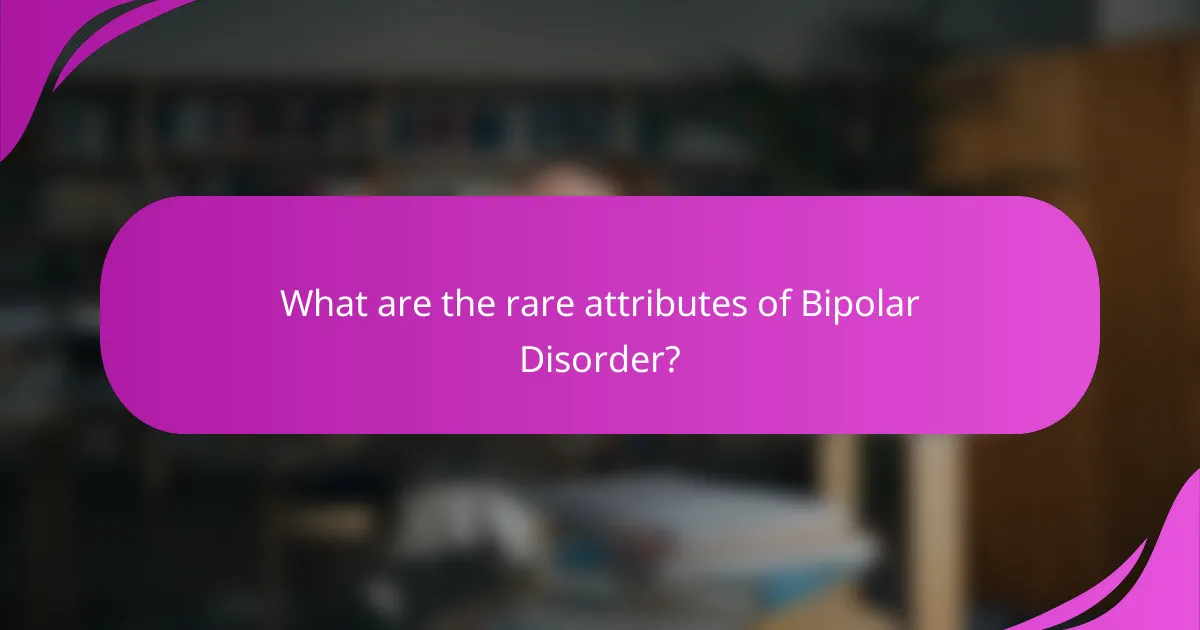
What are the rare attributes of Bipolar Disorder?
Bipolar Disorder can exhibit rare attributes that distinguish it from other mental health conditions. These include the presence of psychotic features during mood episodes, rapid cycling patterns, and a high comorbidity rate with other disorders such as ADHD or substance use disorders. Additionally, some individuals may experience atypical symptoms like hypersomnia or increased goal-directed activity during depressive episodes. Understanding these rare attributes is crucial for accurate diagnosis and effective management strategies.
How can rapid cycling impact treatment options?
Rapid cycling can complicate treatment options for bipolar disorder. It often requires more frequent adjustments to medication and therapy approaches. Patients may respond differently to standard treatments, necessitating the exploration of alternative medications or combinations. Unique attributes of rapid cycling include shorter mood episodes and increased treatment resistance, which can lead to a need for specialized management strategies. As a result, clinicians may focus on mood stabilizers, atypical antipsychotics, or psychotherapy tailored to rapid cycling characteristics.
What is the significance of mixed episodes in Bipolar Disorder?
Mixed episodes in Bipolar Disorder are significant as they combine symptoms of both mania and depression, complicating diagnosis and treatment. These episodes can lead to increased risks of self-harm and impaired functioning. Understanding mixed episodes is crucial for effective management strategies, as they require tailored interventions that address the unique challenges they present. Research indicates that around 40% of individuals with Bipolar Disorder experience mixed episodes, highlighting their prevalence and impact on overall mental health. Early recognition and appropriate treatment can improve outcomes and reduce the severity of these episodes.

What are the most effective management strategies for Bipolar Disorder?
Effective management strategies for Bipolar Disorder include medication, therapy, lifestyle changes, and support systems. Medication, such as mood stabilizers, helps regulate mood swings. Cognitive Behavioral Therapy (CBT) addresses negative thought patterns. Regular exercise and a balanced diet promote overall well-being. Establishing a strong support network enhances coping mechanisms.
How do medication options vary for managing Bipolar Disorder?
Medication options for managing Bipolar Disorder vary significantly based on individual symptoms and treatment goals. Common classes include mood stabilizers, antipsychotics, and antidepressants. Mood stabilizers like lithium are foundational, providing long-term symptom control. Antipsychotics, such as quetiapine, can address acute episodes. Antidepressants may be used cautiously, as they can trigger mania. Each medication’s effectiveness and side effects differ, requiring personalized treatment plans that consider unique patient attributes. Regular monitoring is essential to adjust medications for optimal management.
What role does psychotherapy play in treatment?
Psychotherapy plays a crucial role in the treatment of bipolar disorder by providing strategies for managing symptoms and improving overall functioning. It helps individuals understand their condition, identify triggers, and develop coping mechanisms. Cognitive-behavioral therapy (CBT) is particularly effective, as it addresses negative thought patterns and behaviors. Additionally, psychotherapy can enhance medication adherence and foster a supportive environment for emotional expression. This multifaceted approach contributes to long-term stability and improved quality of life for those affected.
What lifestyle changes can support management of Bipolar Disorder?
Lifestyle changes that support management of Bipolar Disorder include regular exercise, a balanced diet, consistent sleep patterns, and stress management techniques. These strategies can stabilize mood and improve overall well-being.
1. Regular exercise enhances mood and reduces anxiety by releasing endorphins.
2. A balanced diet rich in omega-3 fatty acids and whole grains may positively impact brain health.
3. Consistent sleep patterns help regulate mood and reduce episodes of mania or depression.
4. Stress management techniques, such as mindfulness and yoga, can improve emotional resilience.
Implementing these changes can create a supportive environment for individuals managing Bipolar Disorder.
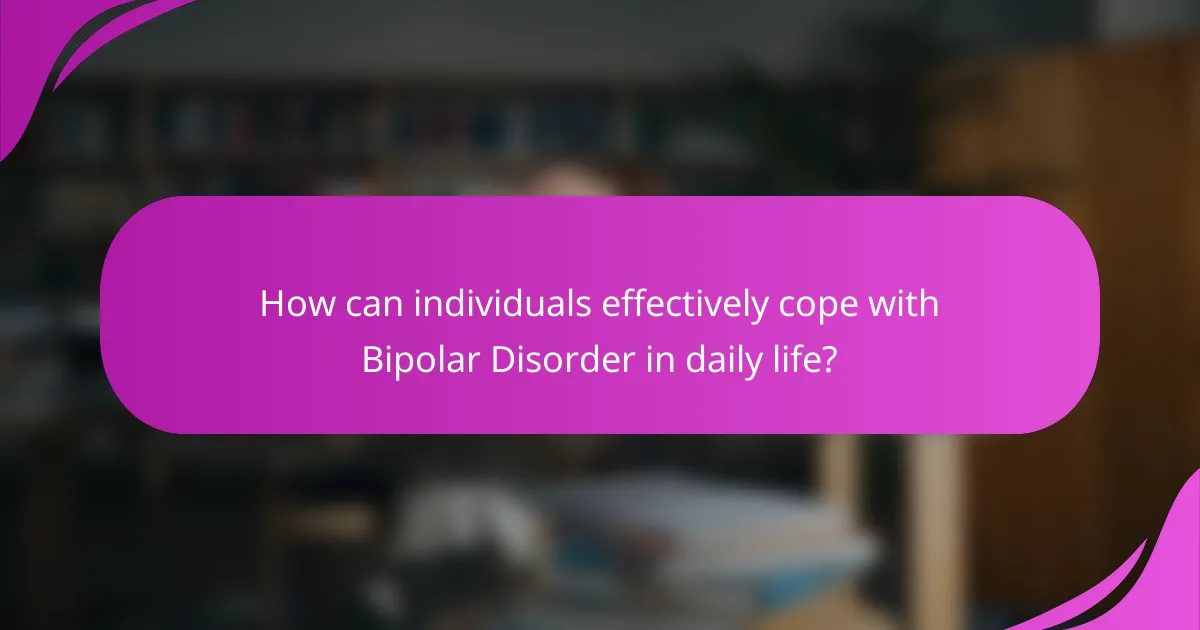
How can individuals effectively cope with Bipolar Disorder in daily life?
Individuals can effectively cope with Bipolar Disorder by establishing a consistent routine, seeking therapy, and maintaining a support network. Regular sleep patterns and exercise help stabilize mood. Cognitive-behavioral therapy (CBT) can provide coping strategies. Medication adherence is crucial for managing symptoms. Engaging in mindfulness practices can also reduce stress and enhance emotional regulation.
What are some best practices for maintaining stability?
To maintain stability in bipolar disorder, individuals should follow consistent routines, engage in therapy, and monitor mood changes. Regular exercise and a balanced diet also contribute significantly to emotional stability.
1. Establish a daily routine to create predictability.
2. Attend regular therapy sessions for support and guidance.
3. Monitor mood fluctuations using a journal or app.
4. Maintain a balanced diet to support overall health.
5. Engage in regular physical activity to reduce stress.
6. Avoid drugs and alcohol, which can trigger mood episodes.
What common mistakes should be avoided in managing Bipolar Disorder?
To manage Bipolar Disorder effectively, avoid common mistakes such as neglecting medication adherence, overlooking therapy, ignoring triggers, and dismissing lifestyle changes. These errors can worsen symptoms and disrupt stability. Prioritizing consistent treatment and self-care is crucial for effective management.
How can support systems enhance management of Bipolar Disorder?
Support systems significantly enhance the management of Bipolar Disorder by providing emotional, social, and practical assistance. These systems include family, friends, mental health professionals, and support groups that foster a sense of belonging and understanding.
The presence of a supportive network can lead to improved treatment adherence, as individuals feel more motivated to follow their management plans. Additionally, support systems can help identify early warning signs of mood episodes, facilitating timely intervention.
Research indicates that individuals with strong support networks experience fewer relapses and improved overall well-being. Engaging in group therapy or peer support can also provide unique insights and coping strategies, further enhancing management outcomes.
What resources are available for individuals and families affected by Bipolar Disorder?
Individuals and families affected by Bipolar Disorder can access various resources for support and management. These include mental health professionals, support groups, educational materials, and crisis intervention services.
Mental health professionals, such as psychiatrists and therapists, provide diagnosis and treatment plans tailored to individual needs. Support groups offer community connections, allowing individuals to share experiences and coping strategies. Educational materials, including books and online resources, help families understand the disorder and its impacts. Crisis intervention services provide immediate assistance during severe episodes, ensuring safety and stabilization.
Accessing these resources can significantly enhance the management of Bipolar Disorder and improve overall quality of life.
